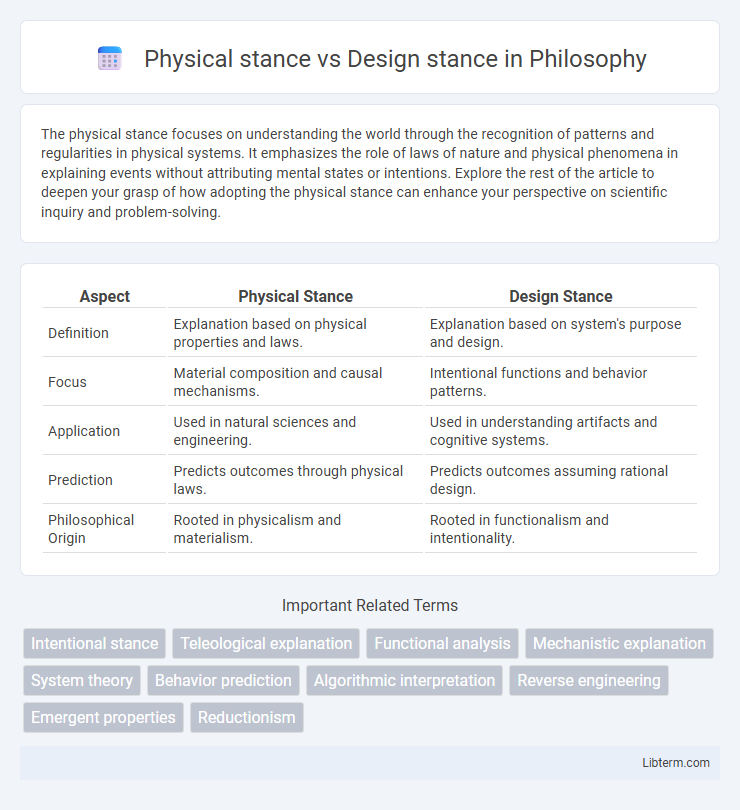The physical stance focuses on understanding the world through the recognition of patterns and regularities in physical systems. It emphasizes the role of laws of nature and physical phenomena in explaining events without attributing mental states or intentions. Explore the rest of the article to deepen your grasp of how adopting the physical stance can enhance your perspective on scientific inquiry and problem-solving.
Table of Comparison
| Aspect | Physical Stance | Design Stance |
|---|---|---|
| Definition | Explanation based on physical properties and laws. | Explanation based on system's purpose and design. |
| Focus | Material composition and causal mechanisms. | Intentional functions and behavior patterns. |
| Application | Used in natural sciences and engineering. | Used in understanding artifacts and cognitive systems. |
| Prediction | Predicts outcomes through physical laws. | Predicts outcomes assuming rational design. |
| Philosophical Origin | Rooted in physicalism and materialism. | Rooted in functionalism and intentionality. |
Introduction to Physical and Design Stances
The physical stance examines objects and systems based on their physical properties, laws of nature, and causal mechanisms, focusing on how components interact in real-world environments. The design stance interprets objects or systems by assuming they are designed with specific functions and purposes, prioritizing their intended operations regardless of underlying physical details. Understanding these stances is critical for analyzing behaviors, where the physical stance emphasizes tangible, mechanistic explanations, while the design stance abstracts functionality and goal-directed design.
Defining the Physical Stance
The physical stance involves understanding an object based on its physical properties, such as material composition, shape, and mechanical function. It emphasizes how an object's structure and physical laws govern its behavior without attributing any purpose or intent. This stance contrasts with the design stance, which interprets an object based on its intended function or purpose created by a designer.
Understanding the Design Stance
The Design Stance involves interpreting an object's purpose, functionality, and intentional design rather than relying solely on its physical properties. This approach enables individuals to predict behavior based on the object's intended use, which contrasts with the Physical Stance that focuses on underlying physical mechanisms. Understanding the Design Stance enhances problem-solving and interaction by emphasizing function and goal-directed reasoning in both everyday objects and complex systems.
Key Differences Between Physical and Design Stances
The physical stance explains system behavior based on its physical properties and laws of nature, emphasizing actual material constitution and interactions. In contrast, the design stance interprets behavior by assuming a system is designed to fulfill specific purposes or functions, focusing on intended roles rather than physical makeup. Key differences include reliance on empirical physical causality for the physical stance versus intentional functionality and purpose-driven explanations in the design stance.
Applications of the Physical Stance
The physical stance is applied in engineering and robotics to predict system behavior by analyzing physical properties, such as materials, forces, and mechanics. It helps in diagnosing technical malfunctions by observing hardware functions and understanding the underlying physical processes. This approach is crucial for developing and troubleshooting devices, ensuring that physical components operate according to scientific principles.
Applications of the Design Stance
The design stance enables predictive reasoning by attributing intentional functions to objects or systems, which is crucial in fields like artificial intelligence and human-computer interaction. By interpreting behavior based on assumed purpose, designers and engineers can optimize user interfaces and troubleshoot software efficiently. This approach streamlines problem-solving in robotics, where understanding intended actions guides programming and adaptive responses.
Physical vs. Design Stance in Artificial Intelligence
The physical stance in artificial intelligence focuses on understanding systems based on their material composition and physical properties, emphasizing hardware and low-level processes. The design stance concentrates on the functional roles and purposes of components, modeling systems by their intended operations and abstract functionalities rather than physical makeup. This approach allows AI researchers to predict behavior and optimize algorithms by prioritizing design over physical structure.
Advantages and Limitations of Each Stance
The physical stance offers a clear understanding of an object's behavior based on its physical properties and laws, providing precise predictions in controlled environments but struggles with complexity and unpredictability in dynamic systems. The design stance simplifies analysis by assuming goal-directed behavior based on an object's intended purpose, enabling efficient problem-solving in engineered systems but often overlooks unforeseen environmental influences and emergent behaviors. Balancing both stances enhances system modeling, yet relying solely on one may result in incomplete or inaccurate interpretations of an object's function and performance.
Real-world Examples: Choosing the Right Stance
Physical stance involves predicting behavior based on the object's physical properties and laws, such as using physics to understand a ball rolling down a hill. Design stance attributes purpose and function to objects or systems, like presuming a thermostat is designed to regulate temperature. Choosing the right stance depends on context: engineers analyzing machinery use the design stance for intended functions, while physicists studying motion rely on the physical stance for accurate predictions.
Conclusion: Integrating Physical and Design Perspectives
Integrating the physical stance, which emphasizes the tangible, mechanical properties of objects, with the design stance, centered on purpose and intentionality, creates a comprehensive framework for understanding artifact behavior. This synthesis enhances problem-solving and innovation by combining cause-effect analysis with functional reasoning. Embracing both perspectives enables designers, engineers, and researchers to predict outcomes more accurately and create more effective, user-centric solutions.
Physical stance Infographic

 libterm.com
libterm.com